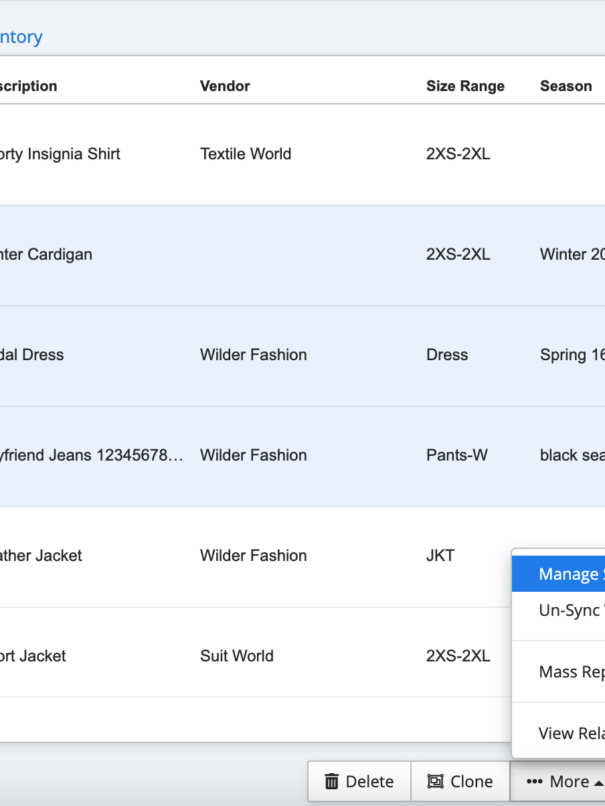Fashion brands are facing a double-edged sword in today’s eco-conscious world – staying on trend, while also minimizing their environmental impact.
Of course, sustainable materials are a key player in this ongoing balancing act, but navigating the complexities of material recyclability is equally important. In this blog, we’ll deep dive into the data and explore the recyclability of five common clothing materials.
Understanding recyclability starts with one key piece of information: Not all fabrics are created equal. The good news is that many materials used in clothing are able to be recycled into new garments. However, the process varies depending on the type of fiber and its blend composition.
Here’s a breakdown of five of the most common materials used in recycled clothing, and the factors that affect their recyclability:
1. Natural Fibers: The Champions of Recyclability!
When we’re talking about natural fibers, this refers to three types of materials:
- Cotton
- Linen
- Wool
These natural champions are the pack leaders in terms of recyclability. The mechanical recycling process breaks down these types of fibers into reusable materials, which can be used to make recycled textiles.
The sweet spot for ideal and efficient recycling with these types of fibers is a blend that contains at least 60% of these natural fibers.
ACTIONABLE TIP: Prioritize using garments with higher natural fiber content whenever it’s possible. If you want a really sustainable choice, consider using organic cottons or linens.
2. Polyester: The Complex Case of Synthetic Fibers
Like natural fibers, polyester (a common synthetic fiber) can be recycled. However, the process requires advanced techniques (i.e., chemical recycling, etc.), to break down the fiber into reusable components, so that it can be used for clothes made from recycled materials.
Blends that have a high polyester content count (70% or higher), are more challenging to recycle. The process used for recycling often struggles to separate these types of synthetic fibers effectively. In turn, this results in downcycling into lower-quality recycled textiles.
ACTIONABLE TIP: Look for garments made from recycled-polyester, rather than new polyester products. This helps to reduce the reliance on virgin materials, which promotes a more circular economy.
3. Nylon: Creating a Sustainable Future with Emerging Innovations
Recycling nylon shares some of the complexities associated with recycling polyester, but new advancements in chemical recycling are very promising. These innovations are improving the recycling process for synthetic fibers; especially pure nylon fabrics.
Using material tracking systems (like ApparelMagic), you can leverage valuable data on the exact fiber composition of specific garments. This gives you the freedom to make educated, informed decisions about the potential recyclability of each nylon blend.
ACTIONABLE TIP: Do what you can to support brands that are pioneering innovations in recycled nylon clothing. Look for certifications or clear labels indicating that the garments include recycled textiles like nylon.
4. Silk: Delicate Elegance with Recycling Limitations
While silk is technically recyclable, the process is complex and often limited, due to the dyes and finishes that are used in preparing silk garments for the market. The fragile nature of silk fibers also makes this process more challenging.
When you’re using silk, transparency is key. Look for brands that are committed to using natural dyes and minimal finishing processes on their silk garments. This can potentially improve the future recyclability of those materials.
ACTIONABLE TIP: Be sure to invest in high-quality silk garments that are designed for longevity. When you can, opt for classic styles that transcend trends, and encourage responsible care processes to extend their lifespan.
5. Blended Fabrics: Each Case is Unique
How recyclable blended fabrics are depends very heavily on the specific fiber combination that the garment contains, as well as their proportions. Separating different fiber types can be challenging, which can have a negative impact on the recycling process.
Through ApparelMagic’s material tracking features, you can access a granular breakdown of each garment’s composition. This empowers your brand to understand recyclability of blended fabrics, and make informed decisions when purchasing clothes made from recycled materials.
ACTIONABLE TIP: Prioritize using garments that are made from a limited number of fiber types; especially natural fibers, like cotton, linen, or wool. This simplifies the recycling process for you in the future.

Beyond the Breakdown: Insights for Sustainable Fashion
Through understanding material recyclability, your brand can make educated choices throughout your design and production processes. Here are some additional insights that you can use to improve your future sustainability:
- Design for Longevity: Create garments using high-quality materials that are built to last. Focus on timeless styles that don’t wane with changing trends. This helps reduce the need for frequent garment replacements, as well as minimizes your textile waste.
- Explore New, Sustainable Materials: Watch out for new innovations in biodegradable and recycled textiles, like hemp and Lyocell. Create a plan to integrate these options into your collection, so that you can provide a truly up-to-date, sustainable approach.
- Embrace Transparency: Don’t be shy about your commitment to sustainable practices! Communicate it clearly in your marketing materials. Let your customers know about the materials that you’re using in your garments, and their potential for future helping to create recycled clothing.
Join the Revolution: Building a Sustainable Fashion Supply Chain
Developing a successful, sustainable fashion strategy involves a lot more than just material selection. Here’s a few of the ways that ApparelMagic’s integrated suite of solutions can empower your brand to build a more eco-friendly supply chain:
- Inventory Management: Efficiently track materials and finished goods to minimize waste, as well as ensure you always have accurate stock levels.
- Sustainable Fashion Practices: Implementing as many sustainable practices throughout your production process as possible, helps reduce your environmental impact.
- Product Lifecycle Management (PLM): Comprehensive PLM solutions will support sustainable product development – from garment design all the way to end-of-life.
- Supply Chain Resilience: Robust supply chain management will ensure your sustainability goals are met, even when you’re facing potential supply disruptions.
Understanding material recyclability empowers brands like yours to make data-driven decisions that support a circular fashion economy. Through prioritizing sustainable materials, optimizing garment design, as well as embracing transparency, fashion can become a force for good!
Are you ready to join the sustainability revolution? Explore how ApparelMagic can help you achieve your sustainability goals. Together, we can create a better, greener future for fashion.







